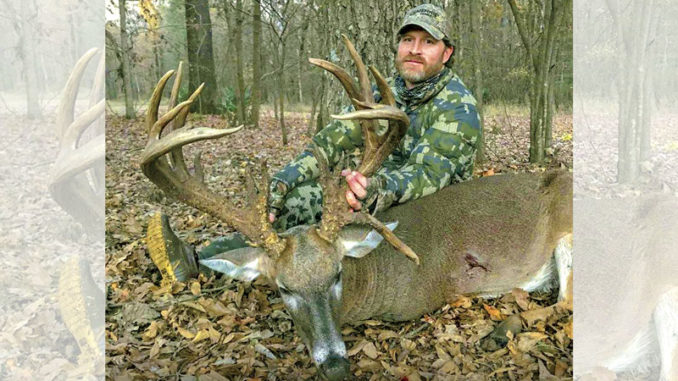
Using ideas from successful hunters can play in your favor when it comes time to put the crosshairs on a trophy whitetail.
I’m not the most successful deer hunter in the woods by a long shot. My success has been marginal, at best, compared with others who seem to almost always realize success with big bucks.
Even so, there have been times, albeit few and far between, when a strategy I implemented ended up with a nice buck on the ground at my feet.
Keep an eye on the girls
Four seasons ago, I had found sign of a nice, heavy-bodied, 8-point buck: scrapes and rubs within sight of my elevated stand. I had a couple of glimpses of him, although I was unable to get him in my scope before he vanished.
In late November, as the rut was starting to kick in in north-central Louisiana, I felt my chances of getting a crack at him would be ratcheted up a notch.
I had been seeing does around my stand, but one morning as they stepped out to feed, they seemed especially nervous. My mind told me there was a buck nearby, causing them to fidget more than usual.
Suddenly, all five does made a speedy exit from my shooting lane, which put me on high alert. I eased my rifle up and got ready. Ten minutes later, I was alerted to movement in the brush and watched the buck I had been hunting step out at 150 yards, nose to the ground where the does had departed. My shot was dead on, and the big-bodied, 225-pound, 8-pointer dropped in his tracks, having succumbed to one of the most-successful scenarios that works for deer hunters year after year.
During the rut, watch the behavior of does to alert you to the presence of an amorous buck. When they seem especially nervous, stare into the woods or dart quickly away, get ready; a buck is likely to step out.
Sit where deer likely walk
Heath Hodges was after a particular impressive buck and had about figured out his movements. He and a hunting buddy had been watching this deer and had him patterned for four weeks. He had seen the deer three times but had never been in the right situation for a shot.
“I actually saw the buck the day before I shot him, and this was the third time I’d seen him during daylight hours,” Hodges said. “We had trail-cam photos of him for the past few years, and he kept getting more impressive each year. After I saw (him) the day before, I moved my stand a little closer to where I’d seen him, hoping that it would pay off.”
Pay off it did, when the buck walked straight toward Hodges’ relocated stand.
Hodges was able to drop that buck because he moved his stand closer to the trail that scouting had revealed the buck was likely to travel. The monster buck sported 20 non-typical points with a green score of an eye-popping 232 inches of antler.
Scouting pays off
Zack Calhoun hunted a box stand in a CRP on his family property; he had killed several good deer in that area over the years. This particular year, however, he was after a buck more impressive than others he had been seeing.
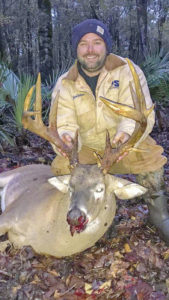
Game cameras showed deer movement only at night, with no photos of the big deer. Calhoun decided that the big buck had found a core area and was hesitant to move out of it. A white oak ridge was 300 yards from his box stand, and Calhoun placed a camera there, getting a photo of the buck the first night, so he knew where this buck has hanging out and was able to figure out where his bedding area was.
Moving a portable stand into the area, Calhoun’s hunch paid off when the buck he was after, an impressive 12-pointer scoring more than 170 inches, walked out late one afternoon; he dropped him.
Both Hodges and Calhoun found the odds in their favor by moving stands to where scouting had shown the bucks were more likely to be seen.
Leave stand; stalk, sit
Bill Harvey, 62, of Monroe, dislikes sitting still in a deer stand, waiting on a buck. He had settled in on a sneak-and-sit approach. Last Nov. 29, while hunting on Davis Island in Madison Parish, Harvey’s method paid off in spades when a main-frame 8-pointer, the biggest buck he had ever seen, came strolling by.
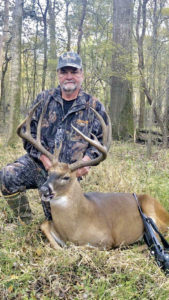
Packing his Thompson Center 7mm Mag, his shooting stick and a dove stool, Harvey headed for a ridge where he knew the wind would favor his hunting style. Two days earlier, he had spotted a really big buck along that ridge, and his son suggested he go back to the same area.
It didn’t take long for Harvey’s hunch to pay off. As he sat on his stool, he watched several deer slip into the area, feeding on acorns. Bringing up the rear, the big buck he had been after stepped out and he was able to drop him.
On public land, take a hike
Often, when deer season opens on public lands, the deer are pressured by the presence of hordes of hunters moving into the woods. Most set up a few hundred yards from where they park, which means deer often retreat into the bowels of the area to escape the pressure.
Brandon Kirby has a favorite public-land area he hunts, and he knows what will happen once hunters hit the woods. His plan involves taking a long walk into the heart of the area to avoid pressure from other hunters.
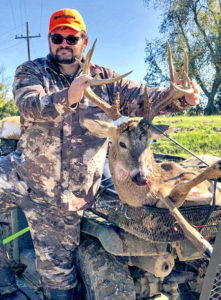
“There is one particular spot on Boeuf (WMA) I like to hunt where I have killed a few deer, but I have to walk three-quarters of a mile to get in there,” Kirby said.
On opening morning of primitive firearms season, Kirby made the long hike back into the bowels of the 51,000-acre WMA, settling in with his Millennium tree seat. He was there when a big 13-point buck stepped into his sight picture, and he connected.
Kirby’s success settled squarely on the fact that he was willing to burn some boot leather and make the long walk away from other hunters into the heart of the area where deer felt safer.
Use trail cameras all year
Last season, of 48 hunters interviewed after killing trophy bucks, a review revealed that 34 utilized trail cameras, some just before and during deer season, but the majority throughout the year.
After the season, cameras can reveal the behavior of deer as antlers are dropped and new ones begin forming. In spring and summer, as new antler growth takes place, photos can reveal how and when growth takes place, and in early fall, as velvet is discarded, hardened racks will help hunters select which trophy bucks to target.
A plus for year-round camera use is simple. It’s just fun.
Plan: get him to the truck
When hunting with a buddy, the task of dragging a 200-pound animal from deep in the woods is less of a struggle, although it’s still an arduous task.
After downing a big buck far back in the woods on Tensas National Wildlife Refuge, Billy Bergeron became a bit concerned because it was getting dark, he was more than a mile from his truck, and Tensas has a healthy population of bears.
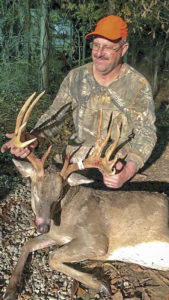
Now, Bergeron uses a cart that he takes into the woods because of what happened the year before. He shot an 8-pointer, and when he recovered the buck, a bear had beaten him to it and was beginning to gnaw on his buck.
“I ran the bear off and got my deer, but as I was leaving the woods with my deer on a cart I take in with me, the bear followed me,” he said.
With no bears around this time, Bergeron was able to successfully get the buck on his cart and make it back to his truck after dark.
Wheeled carts can be purchased, or hunter with an imagination and construction skills, it can be built at home.
Climb high to see
Brandon Bailey has an area he likes to hunt, acreage that includes an area where timber has been thinned a few years before, creating a dense thicket. A buck that had not appeared on camera for three weeks had his attention, and he had a hunch the thick brush served as the deer’s sanctuary.
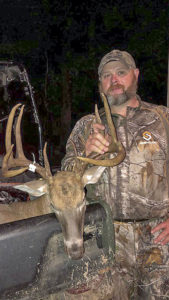
Had Bailey chosen to sit on a stand 10 to 12 feet above the ground, he would not have been able to see into the thicket. But using a climbing stand, he scooted 20 feet up a big pine, giving him a better view into all the rough stuff.
Because of his lofty vantage point, he was able to see the buck when it got up from its bed. He downed the big 10-pointer, that scored 144 inches.
Although safety is a factor to take into consideration, utilizing a safe, sturdy climbing stand and a safety harness will allow a hunter to have a good view into the heart of a thicket, whereas sitting much lower on a ladder or lock-on does not afford this luxury.
Scents can tip the odds
This season, hunters need to be aware of a significant change in the use of deer urine as an attractant. With an eye on chronic wasting disease (CWD), the Louisiana Department of Wildlife and Fisheries has implemented a rule effective Sept. 1. In summary, only synthetic scents or deer urine that has been tested and approved as free of CWD by the Archery Trade Association Deer Protection Program can be used in Louisiana.
Estrous scents could be used with no restrictions until Sept. 1. Not only can such scent attract deer to your stand, it can also mask the hunters travel into the woods to his stand.
Chas Farrell was walking to his stand early one morning last season, and as a precaution, he sprinkled estrous urine at several places along the path he took. Climbing into his stand, he spotted a big buck walking along the same trail he had used.
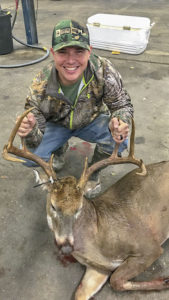
“I really got excited and nervous as I looked at the buck sniffing a branch where I had put some doe estrous as I walked in. I was able to duck down slowly and watched the buck begin walking through the pines toward one of my other shooting lanes,” he said.
Moments later, Farrell put the crosshairs on the buck’s shoulder, touched the trigger, and the big 10-pointer dropped in its tracks.
Hunters must take heed in following the new restrictions regarding use of deer urine as an attractant. However, using urine certified as CWD free by the ATA, or using a synthetic variety, can pay big dividends in bringing a big buck in to investigate.
Management pays dividends
Chet Bolton belongs to a hunting club in Sabine Parish, a tract consisting mainly of piney woods, where members are committed to strict management of deer on club lands. Utilizing trail cameras, they compile a listing of bucks they see and rank them according to size and potential score. Coupled with the use of a supplemental food developed by a member of the club, they have seen the quality of bucks on the club improve significantly over the past few seasons.
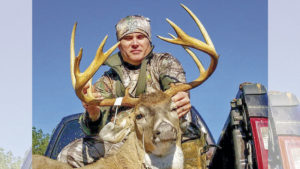
Managing the herd and passing up smaller bucks paid off is spades for Bolton when, hunting one morning, he put his sights on an 11-point buck that weighed over 180 pounds and measured 162 inches, a monster for that part of the state.
Management can pay off significantly if all club members are committed to following agreed-upon rules. Knowing the characteristics of bucks and agreeing to bypass smaller deer can result in even marginal habitat being capable of growing quality deer.
Non-traditional stands
On the afternoon of Nov. 12, 2019, 38-year-old Daniel Colvin planned to walk to his stand on a pipeline, hoping for a chance at a big, 140-inch, 8-pointer he had on camera. However, steady rain created a change in plans; he chose to sit in the living room at his camp in Union Parish to see what might come out on the 6-acre food plot in front of the camp. He made a wise decision when a big 13 point buck he had never seen stepped out, and Colvin dropped him on the spot.
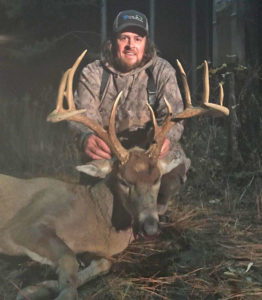
Jacob Cater had a similar experience in Catahoula Parish. Hunting with his wife one afternoon, he decided to sit in a shed on the farm rather than make the long trek to a stand across the bayou.
It paid off in spades for Cater, when a huge, 14-point buck measuring slightly more than 185 inches stepped out into a field the shed overlooked. Had he chosen to head for the stand across the bayou, he’d have never seen the deer.
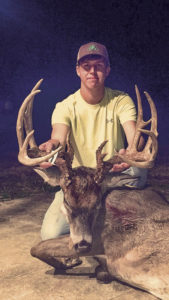
With deer season on the verge of kicking off big time, these tips from successful hunter should pay dividends for hunters targeting wall-hanger bucks this fall and winter.
Bullet point tips for trophy hunters
- During the rut, keep an eye on the girls
- Relocate your stand, if necessary
- Leave the stand; stalk and sit
- For public-land hunts, take a hike; a long one
- Utilize trail cameras throughout the year
- Plan ahead you will get your deer out of the woods
- Climb high to enable you to see into brush
- Legal attractant scent can pay dividends
- Strict management pays off in bigger bucks
- Using non-traditional stands can pay off


